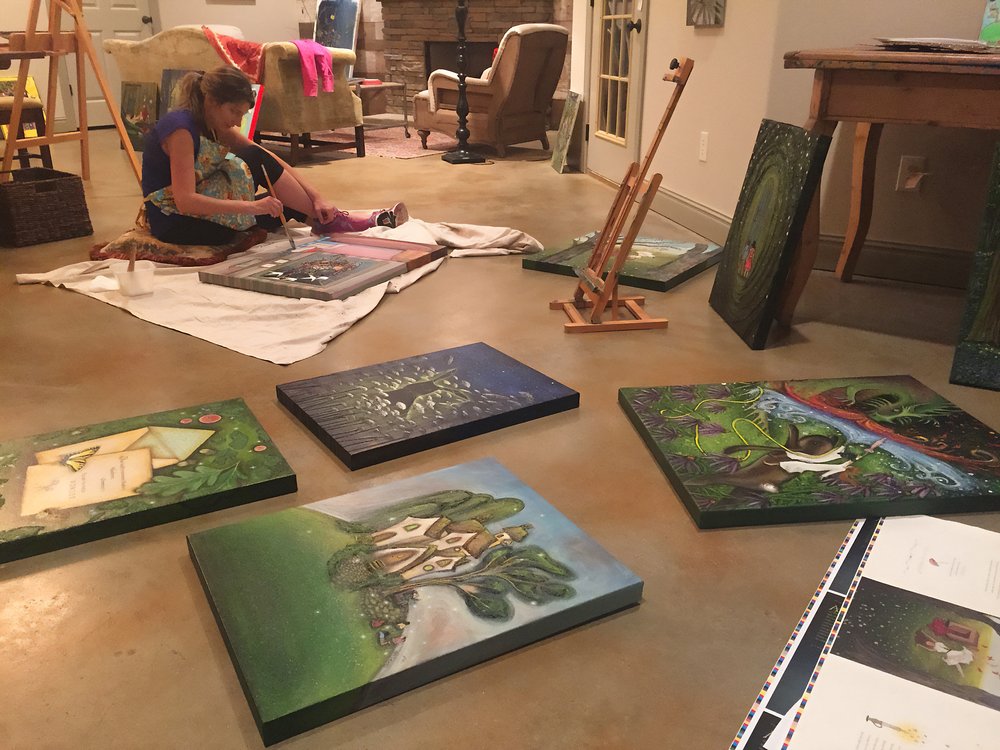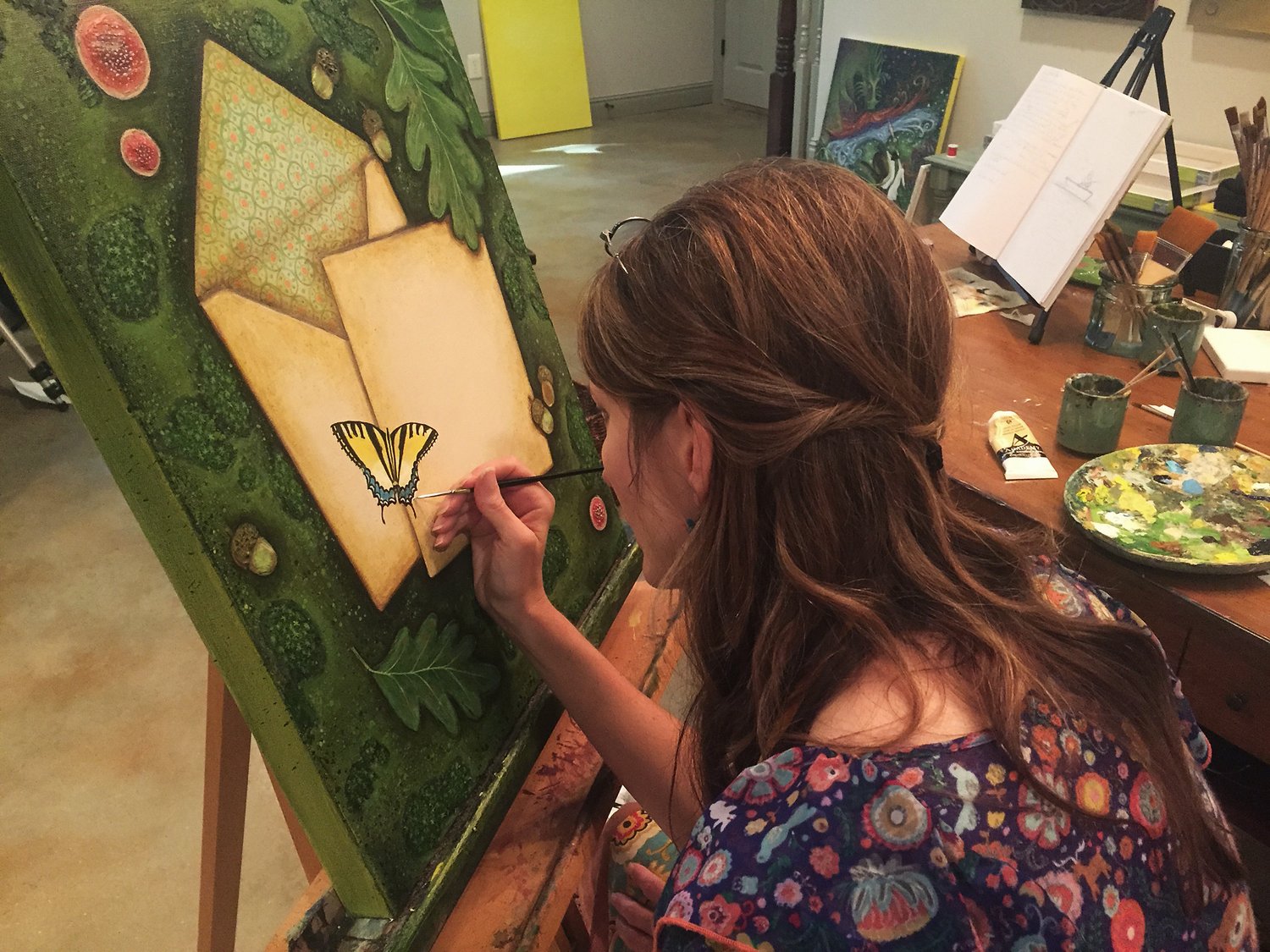“I’m always illustrating the idea of light conquering darkness.”
— Amy Grimes
The Cultivating Project is honored and pleased to continue our conversation with our artist-in-residence, Amy Grimes. Not only is she a wonderful visual storyteller, but she is also a gifted writer of stories that bring us lessons of hope and wonder on every page. Her stories reveal a theme of eternal importance for all ages — that we must follow, trust, and hope in our Father God who loves us and walks beside us in the sunshine and the storms. Amy’s life speaks of an abiding faith and trust in God, with prayers to cover many creative endeavors — a cultivated collaboration with the Lord in all that she writes, draws, and paints. We encourage you to explore her website, where you’ll find her illustrated books, prints, and cards, as well as galleries of her paintings paired with the words that inspired the images.

AN: Amy, our past conversations were an introduction to your gift of telling stories of light and wonder on canvas. Today, we will talk about your illustrated storybooks and upcoming book projects. In his essay “Sometimes Fairy Stories May Say Best What’s to Be Said,” C.S. Lewis wrote, “It certainly is my opinion that a book worth reading only in childhood is not worth reading even then.” There is a challenge in finding a deeply meaningful tale as satisfying for a grownup heart as it would be for children. What are the books that you enjoyed as a child, but with a different depth as an adult?
AG: Certainly C.S. Lewis’s Chronicles of Narnia fit into that category. As a child, I loved the stories—loved the wondrous idea of finding my way into another world through a wardrobe, or a painting, or a mysteriously unlocked door. Those stories led my imaginative play all throughout childhood. George MacDonald’s books, The Princess and the Goblin, The Wise Woman, and The Light Princess had the same effect. Without realizing it, at the time those stories were preparing me to make sense of the light and darkness in the world, and to look for God faithfully and powerfully at work. I think they gave me a taste of God’s goodness. Those stories that used to bring wonder still do, but now the ideas reflected there often bring me to tears because I understand the powerful truth holding them up.
AN: We return to past acts of faith countless times through our lives because we are slow learners! It is good work to reflect back and consider what God has done for us in the past, seeing that He is good and faithful in all things, often in surprising ways! You mentioned before that you intentionally remember beloved stories and special remembrances of the times when God walked with you through the darkness. These reflections are our ebenezers, the “Stones of Help” mentioned in 1 Samuel 7 (ESV), so that we will recall God’s faithfulness. What are your “Stones of Help” that led you to writing your picture books?
AG: Yes! When I’m feeling like a dark cloud has come over me for one reason or another, I love to go for a walk and intentionally remember stories that stir my hope in God. Stories have been so powerful in my life, they can redirect my heart more effectively and efficiently than almost anything else. I know people who feel this same way about looking at the ocean or the mountains. All of these are reorienting reminders that we’re so small and that we’re only seeing our tiny corner of the world at any given moment. So often, when I’m feeling gloomy, I’ve forgotten just how slight my vision is.
“I think despair comes when we believe that what we see at this moment is all there is. But stories and mountains and oceans remind us the absolute truth that there is so much more happening than what we can see.”
Psalm 27:13 says, “I would have despaired unless I had believed I would see the goodness of the Lord in the land of the living.” Many times, my heart has reoriented to hope in the Lord when I remember the beginning of Madeleine L’Engel’s A Wrinkle in Time. Meg Murray, the main character, is feeling gloomy in her attic bedroom as a storm rages outside, making everything feel even gloomier. She has no way of knowing that this is the beginning of an amazing story full of wonder and beauty and redemption. But I know it is because I’ve read the book. So, I remember that scene and the truth hits me afresh: I will see the goodness of the Lord in the land of the living. So, A Wrinkle in Time is one of my favorite stones of remembrance, and I hold it up again and again.
AN: You have mentioned that “writing is more difficult than drawing.” How do you process the ideas from your imagination to the written page? Writing is a challenge because we have the words inside of us, but pouring them out in ink on paper is another matter. Tell us about your writing process. Do you have a routine you use to settle in? Do you carry a notebook to jot down ideas?
AG: Going for a prayerful walk is the best way I’ve found to gather inspiration for writing. But when it comes to sitting down to write, my most important need is uninterrupted quiet time. I have to carve that space out. Painting is so different. I can paint for ten minutes, thirty minutes, an hour, or three hours. The minute I sit down I’m in the project and when I stand up, I’ve paused the project and can return at any moment. But writing is like descending into a well. I can’t get in easily and I can’t get out easily either. Once I’m in, I’m in and it’s not a good time to hear words like, “Hey Mom, do you know what’s for dinner?” So, when my girls were younger, I used to say, “I’m going to be writing for a couple of hours so only say my name if the house is on fire.”

I have so many notebooks with ideas scribbled in them but they’re of little use because they’re so disorderly. Hopefully just writing things down helps me to remember them because I’ll never find them again in all those jumbled notebooks. I had an English teacher in high school who counted notebook organization so heavily that it could drop your final grade by a whole letter if you didn’t perform well. So even though it was my favorite class, I always got a B…
AN: When we hit bottom, or feel scared and alone, the struggle to break free of the darkness can be overwhelming. Your simple solution is such a comfort! You tell us that “Often, when I’ve felt the darkness drawing near, a good story has revived me, confronted me with my own flaws, and stirred my courage.” What books revive your heart and give you courage?
AG: In addition to A Wrinkle in Time, That Hideous Strength by C.S. Lewis, is one that so often revives me—even just the thought of it! In that story, there’s an evil organization that first threatens to take over the small town of Edgestow, and then the world. The great encouragement for me comes through the small company that is assembled to resist the evil. They aren’t warriors and they don’t have a grand plan. For most of the book their form of “fighting” is seen in ordinary acts of faithfulness, seemingly unrelated to the enormous looming threat. There’s a character named McFee who asks again and again—why aren’t we doing something to fight? But the director of the company continues to lead the group to stick to their prayer books and to those small acts of faithfulness. And of course, in the end they’re victorious. And that is so similar to the true story told by Corrie Ten Boom in her book, The Hiding Place. The first part of that book is about her life up until the Nazi’s invaded her home town and all through it I see those small acts of faithfulness that built a foundation of trust in the Lord and prepared her for such big, bold acts of faithfulness that followed.
The Silver Chair by C.S. Lewis is another important story for me. Particularly the part in the Underworld where the evil queen tries to disorient the children and make them question the existence of the sun, and even Aslan himself. And Puddleglum the Marshwiggle keeps reminding them of what is true and drawing them back towards that truth.
“All those stories have given me courage again and again when I’ve needed it most.”
AN: The classic children’s book illustrators like Beatrix Potter and Grant Williams conveyed wonder and enchantment through their art, and your paintings inspire me in the same way. I feel that I am privileged to step into a magical moment in time when I see your settings, children, and creatures. You bring a host of sweet animals into your storytelling; the Night Rabbit and Red Squirrel with his golden circlet and twinkling eyes captured my heart. Who were the first artists to inspire you and why?
AG: Maxfield Parrish was one of the first illustrators to inspire me. I learned how to draw by copying illustrations from the book in my parents’ house. Beatrix Potter was another. I loved the illustrations in The Tale of Miss Tiggywinkle and The Tale of Miss Tittlemouse the very most. And I also loved Gyo Fujikawa’s illustrations. I still remember exactly what I loved most as a child about all of those artist’s pictures and that helps me a lot as I create my own illustrations today. I make sure to include the kinds of things I most loved to see. I loved the patterned clothing, little flowers and mushrooms, and views inside houses that made me wish to see more.
AN: A picture is worth 1,000 words. The imagery we see in a painting creates poetry in one imagination, a story in another, and a maelstrom of magical words for someone else. What qualities do you believe are essential to draw out meaning in an illustrated story book?
AG: I think color is awfully important when it comes to communicating a story. I like to first consider what mood I’m trying to set. Is it magical? Mysterious? Gloomy? And then that helps me to choose the colors I’m going to work with. I also like to say to myself, “What is the most powerful image I can think of that tells this story?” And I don’t usually choose the first one that comes to mind. I like to consider lots of ideas and pick the one that really shouts the message I’m trying to share. I do a lot more thinking than sketching or painting. Painting comes at the very end of the process.
AN: The Story of Lucilla and the Snarly Skein is infinitely relatable because we have all experienced troubles that we want to just fix on our own. What an important lesson for us to learn as children! It is so difficult to put our problems into the hands of God and then leave them to Him. As adults, we want to fix it, or fix life for our children, but God has a purpose for the tangle. And the Light Comes In is a magical invitation to keep wonder in your heart and imagination. Light is so unique — what inspired you to write a book that includes clever prompts for conversations?
AG: My oldest daughter inspired me to include those prompts. When she was very little I painted a picture of a fairy princess sitting on a rock in the moonlight with mason jars sitting on the ground all around. My daughter used to pull one of the dining room chairs into the hallway where that painting hung on the wall and she would stand on the chair and look closely at the painting. She would say, “What’s in the jars?” And I would always answer her, “What do you think is in them?” And she would guess all sorts of things. It’s really the same thing I did when I used to look at picture books and focus in on small details that made me wonder. So when I wrote And the Light Comes In, I wanted to intentionally stir children’s imaginations so that they would take the story further with their own minds.

AN: Embracing wonder in all that you create is a true gift, and you have painted images that are “too beautiful to ignore,” which is your hope and prayer for all that you make. You have written and illustrated several children’s stories, including Voyage to the Star Kingdom, a collaboration with Anne Riley. This was your first children’s book and it engaged with the difficult subject of death. Stories are humanity’s oldest art form. They can guide us through difficulty and help us to recall and recover our past. Why did the idea of writing about difficult events in a child’s life appeal to you?
AG: It was Anne who first thought to create Voyage to the Star Kingdom because of a family we both knew whose two youngest daughters were suffering with Batten’s disease, which is terminal. She wanted to comfort the family with a story. Anne asked for my help and I said yes, but I was afraid to do it—fearful that we might accidentally add to the pain the family was feeling. I prayed and prayed that God would help us create a story that would only help and not hurt, and that is exactly what He did. I’d have never been involved in it if it weren’t for Anne’s courage and confidence in what we were doing. That’s one of the great gifts God gives in collaboration. We can lend one another courage when we work together.
AN: Your illustrations contain a light, as well as a mystery. Even in the darker images, like “Amelia and the Love Bird” and “The King’s Light,” we see a glimmer of sweet anticipation and optimism. How do you translate that illumination into prose?
AG: I think of it as acknowledging the darkness, but focusing on the light. My favorite stories do that too. When I’m trying to create a painting that involves victory over darkness, I typically need a dark background. And when I’m mixing paint, I avoid using any white. I save the white and bright yellow for the elements that I want to “win” in the painting.
AN: You mentioned in a prior interview that you “used to spend hours looking at a big, blue, clothbound book of Maxfield Parrish’s paintings and imagining the stories behind them.” Parrish’s works are pure fairytale, myth, and magic, the brightest imaginings. My family will comment on a particularly ethereal sunrise or sunset with “Look! It’s a Maxfield Parrish sky!” Your paintings, like his, are so distinctive because they embody light and wonder and fairy tales, capturing a transcendent moment in time. Does his work still influence you?
AG: Thank you so much for your kind words, Annie! And yes—that same book is open to one page or another very often in my studio. I have all my favorite books from childhood there, and I use them to help me remember what I’m trying to accomplish. They help me so much with color and mood. I think of them as my teachers.
AN: Amy, when I look at your lovely illustrations, my heart lifts and joy slips in. I am reminded of the words of this precious hymn by Helen H. Lemmel:
O soul are you weary and troubled
No light in the darkness you see.
There’s light for a look at the Savior,
And life more abundant and free.
Turn your eyes upon Jesus,
Look full in his wonderful face.
And the things of earth will grow strangely dim,
In the light of his glory and grace.
I read the theme of this hymn in your children’s stories — peace, grace, and light overcoming darkness. Are there certain hymns that resonate with your imagination?
AG: My very favorite hymn, that I cannot sing without tears coming to my eyes, is “Come Thou Fount of Every Blessing.” And my favorite verses from that wonderful song are:
Jesus sought me when a stranger
Wandering from the fold of God
He to rescue me from danger
Interposed His precious blood
And then later in the hymn:
Prone to wander, Lord I feel it
Prone to leave the God I love
Here’s my heart, oh take and seal it
Seal it for Thy courts above
I’m so thankful—much more than I can say—that God rescued me from wandering through life without Him. He is the greatest gift! And I want to share with others, through art and story, about His trustworthy character and His amazing power to save and to help.
AN: The George MacDonald Christmas Collection is now available just in time for the upcoming holiday season. These selections, including The Gifts of the Child Christ, give us a “charmingly diverse ensemble” that embodies the Christmas spirit. You illustrated the cover and David Jack, a George MacDonald scholar, gathered the prose for this wonderful text. David told me, “When I saw her artwork on Instagram, I knew she would be a great fit as a MacDonald illustrator. The Christmas book was the first real opportunity to team up. Amy’s work has a charm to it that I thought would be especially fitting for a book of fairy tales or festive stories. Her style coalesces perfectly with the Christmas theme.” What is the story behind this collaboration?
AG: I’ve gotten to know David Jack through Instagram and Facebook because of his translation work on various George MacDonald books. George MacDonald’s writing has had such an impact on my life, starting in childhood, and David Jack is an expert on all things George MacDonald. I used to think that surely no one loved George MacDonald’s writing as much as I did, but after getting to know David Jack and many other MacDonald fans, I realize I was silly to think that. He’s read MacDonald stories that I’d never even heard of and he sees symbolism I never noticed. It was a privilege to be able to paint the cover of his George MacDonald Christmas Collection.
AN: The theme for Cultivating this season is telos. In the original Greek, telos means the end purpose or the ultimate object or aim. What is your highest aim as you illustrate and write?
AG: I want to share what I see when I look at God. I want to tell people that He is good and kind and wondrous and awe-inspiring. I want to give my best effort to stir faith—to stir the idea that there is more to the story than what is seen with limited human vision. God is the source of peace and hope and I really want to point people to that source.
![]()
The images of Amy are by her husband Russ Grimes and used with permission for Cultivating.
You can discover more of Amy’s story paintings and books on her website at StoryPaintings, and follow along with her on Instagram.
Annie Nardone is a lifelong bibliophile with a special devotion to the Inklings and medieval authors. She is a Fellow with the C.S. Lewis Institute and holds an M.A. in Cultural Apologetics from Houston Christian University. Annie is the Director of Visual Artists for The Cultivating Project and columnist for Cultivating Magazine. She is founding board member, managing editor, and author for the apologetics quarterly, An Unexpected Journal. Her writing can also be found as travel blogger for Clarendon Press U.K., with published poems at Calla Press and Poetica.
She holds a MA in Cultural Apologetics from Houston Christian University, and is a Fellow with the C.S. Lewis Institute. Annie writes for Cultivating, Literary Life, and Clarendon House Books, and is a managing editor and writer for An Unexpected Journal. Annie collaborated on three books in 2022, published by Square Halo Books and The Rabbit Room. She recently designed a curriculum detailing the intersection of theology, the arts, and history and is a Master Teacher for HSLDA. She resides in Florida with her Middle Earth/Narnia/Hogwarts-loving family, and an assemblage of sphynx cats and feline foundlings.
Leave a Reply
A Field Guide to Cultivating ~ Essentials to Cultivating a Whole Life, Rooted in Christ, and Flourishing in Fellowship
Enjoy our gift to you as our Welcome to Cultivating! Discover the purpose of The Cultivating Project, and how you might find a "What, you too?" experience here with this fellowship of makers!


Add a comment
0 Comments